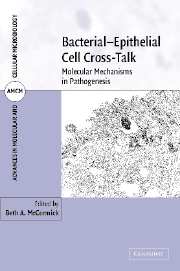Book contents
- Frontmatter
- Contents
- List of contributors
- Part I Introduction to the host and bacterial pathogens
- Part II Bacterial cell biology and pathogenesis
- Part III Host cell signaling by bacteria
- 8 Host-mediated invasion: the Salmonella Typhimurium trigger
- 9 NF-κB-dependent responses activated by bacterial–epithelial interactions
- 10 NF-kB-independent responses activated by bacterial–epithelial interactions: the role of arachidonic acid metabolites
- Part IV Exploitation of host niches by pathogenic bacteria: mechanisms and consequences
- Index
- Plate section
- References
8 - Host-mediated invasion: the Salmonella Typhimurium trigger
from Part III - Host cell signaling by bacteria
Published online by Cambridge University Press: 12 August 2009
- Frontmatter
- Contents
- List of contributors
- Part I Introduction to the host and bacterial pathogens
- Part II Bacterial cell biology and pathogenesis
- Part III Host cell signaling by bacteria
- 8 Host-mediated invasion: the Salmonella Typhimurium trigger
- 9 NF-κB-dependent responses activated by bacterial–epithelial interactions
- 10 NF-kB-independent responses activated by bacterial–epithelial interactions: the role of arachidonic acid metabolites
- Part IV Exploitation of host niches by pathogenic bacteria: mechanisms and consequences
- Index
- Plate section
- References
Summary
INTRODUCTION
The epithelial layer of mucosal surfaces in the gastrointestinal tract is a busy surface for communication between the host and both commensal and pathogenic bacteria. In the case of invasive pathogens, the epithelium represents the major barrier that has to be overcome. Important virulence determinants include those mediating adhesion to and invasion of the epithelium. Different strategies are used to induce the uptake of invasive bacteria (Figure 8.1). For example, Yersinia spp. and Listeria monocytogenes express adhesins that bind tightly to host cell-surface proteins. This binding interaction initiates invasion by triggering signaling pathways normally involved in the regulation of cell adhesion. This invasion mechanism has been termed “zipper” because the host cell membrane is wrapped tightly around the bacteria (Mengaud et al., 1996). For more details on the zipper mechanism; see Alonso and Garcia-del Portillo (2004). More recently, a variant of this mechanism, termed the “tandem β-zipper,” has been identified. As an example of this entry mechanism, pathogenic bacteria like Staphylococcus aureus express surface proteins that bind to human fibronectin. This fibronectin coat facilitates binding to host cell-surface receptors and mediates invasion (Figure 8.1b) (Schwarz-Linek et al., 2004). A third strategy, termed “trigger mechanism,” is employed by Salmonella and Shigella spp. This involves specialized protein-transport systems called type III secretion systems (TTSS) to inject virulence factors (effector proteins) directly into the cytosol of the host cells. The translocated effector proteins trigger host signaling cascades that mediate a variety of responses, including pathogen uptake (Hueck, 1998).
- Type
- Chapter
- Information
- Bacterial-Epithelial Cell Cross-TalkMolecular Mechanisms in Pathogenesis, pp. 213 - 243Publisher: Cambridge University PressPrint publication year: 2006



